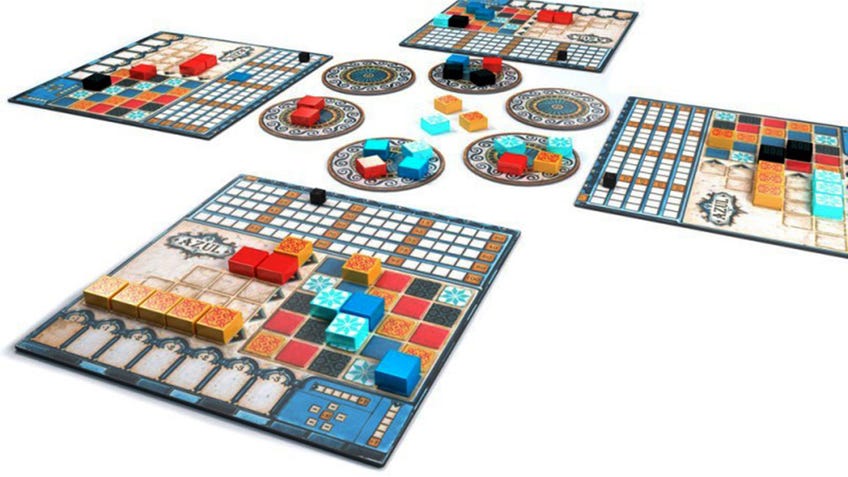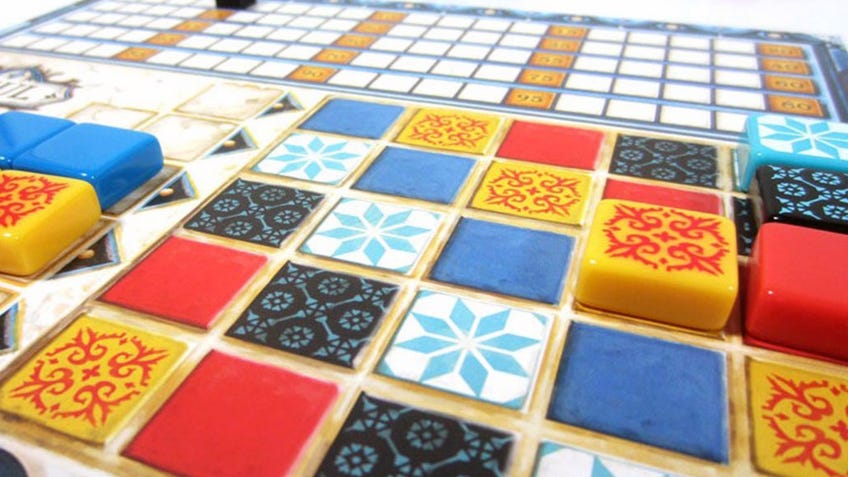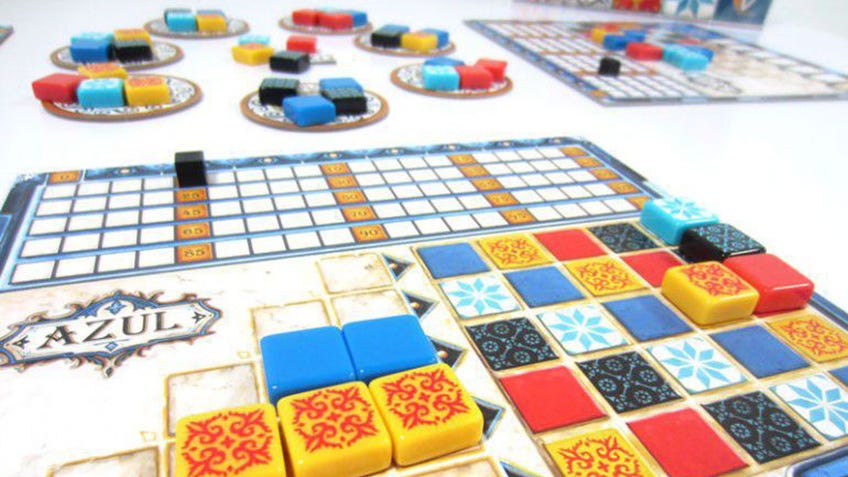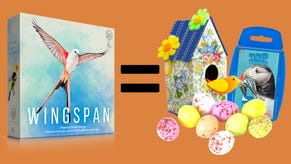How to play Azul: board game’s setup, gameplay rules and scoring explained
Tiling without the tiring.
In the few years since it first hit the table in 2017, Azul has quickly become both a critical and commercial success story, scooping major awards including the prestigious Spiel des Jahres ‘Game of the Year’ prize and shifting more than a million copies. Not bad going for a board game inspired by the not-particularly-exciting task of tiling walls.
In the game, players take turns to pick tiles of a particular pattern from a series of ‘factories’ on the table, filling up rows on their individual player board before transferring any completed rows to their ‘wall’ at the end of the round. By adding tiles to the wall and completing rows and columns, the players score increasing numbers of points - as long as they can avoid smashing any tiles by overfilling a row, that is.
Designer Michael Kiesling’s quick-to-learn yet engrossingly strategic - and, at points, intensely competitive - gameplay has earned Azul a place as one of the best board games for beginners to pick up first, alongside such perennial modern classics such as Ticket to Ride, Catan and Codenames.
How to play Azul
- Player count, game length and overview: How many people does Azul play with? How long does Azul take to play? Everything you need to know before opening the box.
- Setup: Get ready to play with the correct setup and layout for any number of players.
- Gameplay: It's time to actually start playing as we run through Azul's rules and what you'll be doing on your turn.
- Scoring and end of the game: Count up your points and see if you've won!
Azul has since gone on to see two standalone sequels - the window-making Stained Glass of Sintra and starry Summer Pavilion - each with their own unique variations on the original’s gameplay rules and inventive scoring, as well as its delightfully clacky Starburst-like plastic tiles.
If you’re yet to play any of the series, the original Azul is still the best place to start, introducing you to its tile-drafting gameplay and combo-building scoring as you fill your wall with colourful tiles in pursuit of points. Once you know the basics of how to play Azul, moving on to Stained Glass of Sintra or Summer Pavilion is easy, giving you plenty of new moves, decisions and strategies to explore. Let’s get started.
Player count, game length and overview
Azul is a board game for two to four players that plays in 30 to 45 minutes. In the game, you are tilers working on the walls of the Royal Palace of Evora and hoping to create beautiful patterns to impress King Manuel I.
Setup
Give each person a player board. You can choose to play using the standard side with the multi-coloured wall on the right, or an advanced variant where you can arrange your tiles more freely by using the grey wall. (For your first few games, we recommend playing the standard mode.) Whichever you pick, everyone has to use the same side. Place a scoring marker - that’s the little black cube - on the zero space of your board’s point track.
Arrange the circular boards in the middle of the table. These are called factories. You need five factories for two players, seven for three players and all nine for four players.
Give the first player marker - that’s the white tile with the 1 - to the person who most recently went to Portugal. If nobody’s been to Portugal, pick whoever’s name starts with the letter closest to A.
Fill the bag with the rest of the coloured tiles. Randomly draw 4 tiles and put them on each of the factories. You’re ready to play!

Gameplay
In Azul you’re aiming to add tiles to your wall in order to score points. Your wall is the section on the right-hand side of your board. You add tiles to your wall by first forming complete rows of matching tiles on the left side of the board. You fill the rows by claiming tiles from the factories.
At the beginning of every round, the player with the first player marker places it in the middle of the table. They will take the first turn.
The first phase of each round involves players taking it in turns to either claim tiles from one of the factories or the middle of the table.
When you claim tiles from a factory, you must take all of the tiles of the same colour from that factory. Any tiles of a different colour are added to the middle of the table.

Instead of taking from a factory, you can claim tiles from the middle of the table. Again, you must take all of the tiles of the same colour. If you are the first player to take from the middle of the table, you must also claim the first player marker and add it to your floor line at the bottom of your player board - we’ll explain what that means in a second.
When you claim tiles, you must add them to one of the rows on the left of your player board. You can only add the tiles you claimed that turn to a single row, but you can choose which row to place them in - except in later rounds, when you cannot place tiles in a row which already has a tile of that colour on the wall.
You’re aiming to fill an entire row with tiles, filling the spaces from right to left. If a row already has one colour in, you can’t add tiles of another colour to the same row. You can add tiles of the same colour to a row left incomplete during an earlier turn.
Each row holds a different number of tiles, from 1 to 5. Any tiles that do not fit in the row you’re filling must be added to your floor line, along with the first player marker if you claim it from the middle of the table. The floor line is worth negative points at the end of the round - each space that’s filled loses you that number of points. That’s right - each space. (Don’t worry, you can’t end up with fewer than zero points.)

Once all of the tiles have been claimed from the factory boards and the middle of the table, the second phase of the round begins. It’s time to tile your wall!
During this phase, everyone can carry out these steps at the same time.
Starting with the top row on your board, for each complete row of matching tiles on the left, you add a tile of that colour to your wall on the right.
When you add a tile to the wall, you score 1 point if it isn’t touching any other tiles.

If the tile touches any tiles in the same row or column, you score bonus points. You score 1 point for each connected tile in the same row or column, plus 1 point for the tile you just placed. This includes any tiles next to those tiles in the same row or column as the tile you just placed too, and so on. Important: when adding up your bonus for the row and column, count the tile you just placed again if there are connected tiles in both the row and column. For example, if you place a tile and there is one tile above it and one tile to its side, you would score 4 points.
After adding up your score and moving your score marker, take away points for any tiles in the floor line - remember that you lose each amount of points for a filled space.
Used tiles (except the first player marker) are placed in the box lid - use them to refill the bag if it runs out. Refill the factories with 4 tiles each from the bag, and begin a new round!
Scoring and end of the game
The game ends when one player completes a full row of tiles on their wall. You play to the end of the current round, including tiling your wall and scoring as usual.
Once the normal scoring has taken place, the final round has one final scoring phase. Players score 2 points for each complete row they have on their wall, plus 7 points for complete columns they have. If you have five tiles of a matching colour on your wall, score 10 points - this applies to each tile colour.
After you’ve added everything up, the highest score wins! Ties are won by whoever has the most complete columns.








